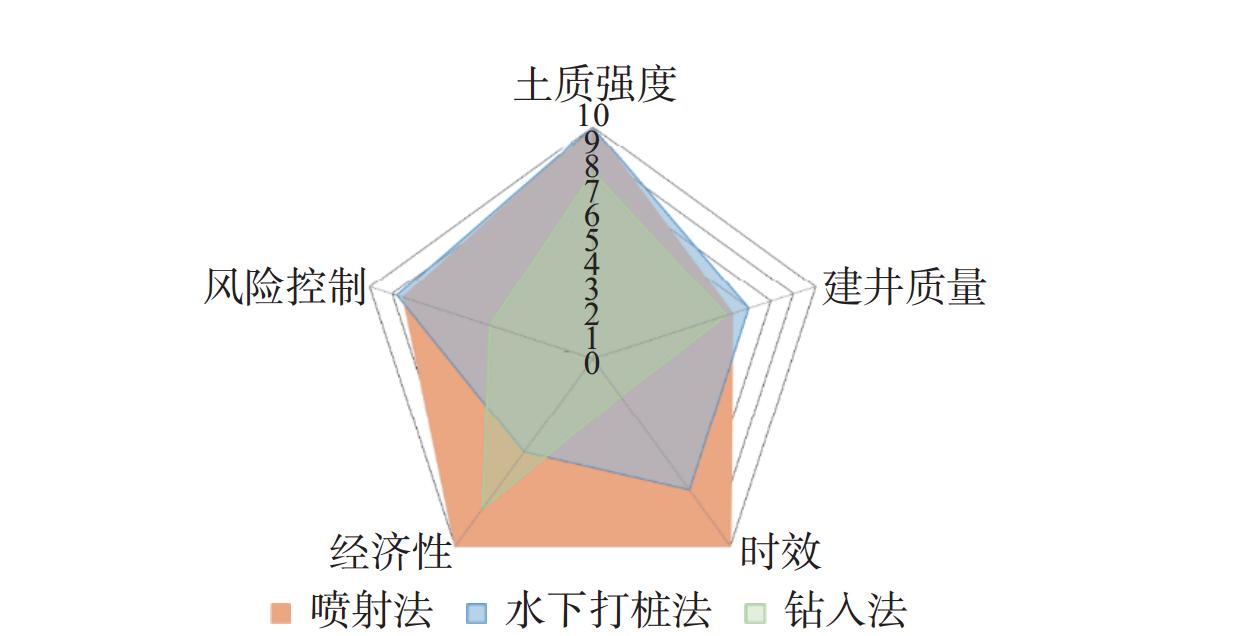Multi-Dimensional Selection Method for Well Construction in Shallow Formations of Deepwater
-
摘要:
深水钻井作业具有海洋环境多变、地质条件复杂、作业风险大和日费率高等特点,深水浅层建井的方式难以选择。针对海底土质强度、建井质量、作业时效、经济性、风险控制等因素,根据现场作业工程数据,分别对不同建井工艺的适应性进行了分析,建立了单维度的适应性分级机制,并借助雷达图进行定量可视化,形成了多维度深水浅层建井方式优选方法。研究结果表明,水深500~1500 m的南海北部海域,单井作业时,喷射法一般为浅层建井最优方法,作业效率相比钻入法可提高50%以上。该方法已在中国南海几十口深水井取得良好应用效果,可为深水复杂地层建井方式选择提供定量评价方法。
Abstract:Due to the characteristics of variable marine environment, complex geological conditions, high operational risks, and high day rates of deepwater drilling operations, it is difficult to choose suitable method for well construction in shallow formation in deepwater. Taking into account all relevant factors, including seabed soil strength, well construction quality, operation efficiency, cost efficiency, drilling safety risk control, and other factors, the adaptability of different well construction methods were analyzed based on the field operation engineering data. A single-dimensional adaptability classification mechanism was established, and a multi-dimensional selection method for well construction in shallow formations of deepwater was formed through quantitative visualization using radar charts. The results show that in the South China Sea with a water depth of 500−1500 meters, the jetting method is the optimal method for well construction in shallow formation during single well operation, and the operation efficiency can be improved by more than 50% compared to the drilling method. This method has achieved good application results in dozens of deepwater wells in the South China Sea, which provides a quantitative evaluation approach for the selection of well construction methods in deepwater complex formations.
-
CO2驱油作为三次采油的重要手段,可在提高采收率的同时实现CO2捕集和封存,有助于“双碳”目标的实现,为绿色低碳环保开发提供了技术支撑[1-4]。苏北油田低渗透油藏较多,注水驱油困难,于2005年在草舍油田泰州组油藏进行了CO2驱油先导试验,鉴于前期增油效果较好,目前苏北油田CO2驱油开发的单元已增至15个,其中草中阜三段、台南阜三段等油藏均取得了较好的开发效果[5-7]。
苏北油田CO2驱油开发单元使用常规笼统注气工艺时存在吸气剖面不均匀、高渗层气窜严重和低渗层动用程度低等问题,严重制约着CO2驱油的增产效果,限制了CO2驱油技术的进一步推广。针对上述问题,在分析传统分层注气工艺特点的基础上,结合苏北油田注气井地层情况和完井结构,借鉴国内分层注气技术,设计了分层注气管柱和配套了调配等技术,形成了CO2驱油同心双管分层注气技术,提升了长期注气可靠性和调配精度。该分层注气技术操作简单可靠,可实现高精度分层调配。
1. 常规分层注气工艺
1.1 油套分层注气工艺
常规油套分层注气管柱采用水力锚+封隔器+喇叭口组合,利用油套环空通道和油管通道分别对上下层注气;井口安装2套地面定量配气装置,分别控制上下层段的注气量。
油套分层注气管柱结构简单,可实现分层注气量地面调配,但存在以下缺点:油套分层注气管柱气密封性和可靠性较差,长期注气易造成封隔器解封困难,影响修井作业;上部油层套管长期承受注气高压,且CO2易腐蚀套管,造成套管错断等问题。
1.2 同心测调一体分层注气工艺
同心测调一体分层注气工艺利用测试电缆将测调仪下入井筒内,与可调气嘴对接后根据地面指令进行调节,并将井下流量、压力等数据传输至地面。
该工艺能够满足多段分注的要求,但存在以下缺点:配气器的气嘴易刺坏,对材质要求较高;井下测调需采用特制钢管电缆,以保证密封性,成本较高;井下测调施工复杂,井口操作风险较高;CO2在地层条件下为超临界状态,常规流量计不能正常工作,新型井下CO2流量计设计难度大。
1.3 有缆式智能分层注气工艺
有缆式智能分层注气设备主要包括有缆智能配气器、过电缆封隔器和地面控制系统等。每个注气层段对应一个智能配气器,利用电缆连接地面控制系统,通过控制气嘴开度控制各层注气量。
该工艺具有可实时调配注气量、操作方便等优点,但电缆需随井下工具入井,对施工质量要求较高;电子元件在井下高温高压环境下易失效,可靠性较低,且更换井下电子元件时需要起下注气管柱,成本较高;井下环境中CO2流量计计量误差较大。
2. 同心双管分层注气技术设计思路
针对传统分层注气工艺存在的不足,为保证分层注气管柱在高压差下保持不失稳,分层注管气柱需具有较好的稳定性;为保证套管起压率较低,同心双管分层注气管柱需具有较好的气密封性;为降低后期作业成本和缩短施工周期,同心双管分层注气管柱应具有防回流的功能;为保证同心双管分层注气管柱的使用寿命,需具有一定的防腐蚀性能;为保证注气量调配施工安全高效,保证较高的调配成功率和调配精度,流量误差需控制在10%以下。
2.1 技术原理
同心双管分层注气管柱设计了2条注气通道,分别通过外管柱与内管柱的环空和内管柱对上、下层位注气。同心双管分层注气管柱主要由注气外管柱、注气内管柱、注气封隔器、注气阀、注气丢手接头和分注器等构成(见图1)。注气丢手接头和Y445型注气封隔器的丢手机构使同心双管分层注气管柱具备了较好的丢手性能,能够满足后期施工不同工况下的丢手要求。
2.1.1 同心双管分层注气管柱结构
注气外管柱从下至上由多功能注气阀+Y441型注气封隔器+注气丢手接头+分注器+Y445型注气封隔器+外管滑套+ϕ73.0 mm气密封油管组成。注气内管柱从下至上由内插管+中心管+内管滑套+ϕ36.0 mm空心杆组成。
同心双管分层注气管柱中,分注器起枢纽作用,将内外管来气分别输送到不同层位,在外管下入完毕后,再下内管,最终通过插入密封机构完成内外管连接。分注器设置有侧流道和中心流道,在径向上外壳和密封外管之间形成侧流道,密封内插管和密封外管轴向芯部共同构成中心流道。多功能注气阀使注气管柱具备了防回流的功能。注气井停注时,井底流体压力将球压紧在球座上,无法回流至油管内,实现了注气管柱的安全控制。
2.1.2 管柱气密封性设计
1)注气油管设计。注气油管使用笼统注气工艺广泛使用的ϕ73.0 mm气密封特殊螺纹油管,以保证注气管柱的气密封性。该油管的上扣扭矩为2 580~3 030 N·m,最佳扭矩为2 810 N·m。为使气密封油管上扣达到规范要求,使用扭矩控制记录仪控制气密封油管上扣扭矩,设定扭矩范围,要求油管上扣扭矩曲线符合标准。
气密封油管入井前需进行气密封性检测。气密封油管完成上扣后,内部下入带有上、下2个胶筒的封隔器,卡封油管丝扣两端形成密封空间,然后注入含有氦气的混合气。若探测设备在外部未测到氦气泄漏,说明油管丝扣气密封性符合要求;若探测到氦气泄漏,说明油管丝扣的气密封性不合格。
2)空心杆设计。内管选用ϕ36.0 mm空心杆,采用氢化丁腈橡胶材质的O形密封圈,以保证气密封及耐CO2腐蚀性能。空心杆上扣后,需测试其气密封性,以确保满足分层注气要求。
2.1.3 防腐性能
为保证注气管柱防腐性能,选用3Cr材质的油管,井下工具钢体采用30Cr13不锈钢材质。注气封隔器的胶筒和井下工具的密封部件采用抗CO2气侵的氢化丁腈橡胶。向油套环空注入咪唑啉类CO2缓蚀剂,增强套管防CO2腐蚀性能[8-13]。
2.1.4 施工步骤
1)组配并下入注气外管柱,管柱下至设计深度后,向油套环空注入CO2缓蚀剂。
2)通过磁定位调整管柱下入深度,坐封封隔器,打开多功能注气阀。
3)组配并下入注气内管柱,管柱下至设计深度后,打开分注器,加压,验证封隔器、空心杆等的气密封性。
4)连接地面分注调配系统,调整阀门试注。
5)开始注气,调整地面流量控制闸门,控制上、下层位的注气量。
2.2 技术特点
该工艺能够实现细分层注气的目的,主要具有以下特点:1)调配效率高。免去了仪器调配工序,大幅提高了工作效率,降低了成本。2)调配成功率高。利用地面节流阀调节注气量,调配成功率和调配精度较高[14-17]。
2.3 技术优化
2.3.1 长期注气可靠性
初期设计了2种同心双管分层注气管柱,分别是“Y441型注气封隔器+Y341型注气封隔器”管柱和“Y445型注气封隔器+Y441型注气封隔器”双级锚定式管柱。前1种管柱包括Y441型注气封隔器、Y341型注气封隔器和配注器等。因Y341型封隔器坐封后无锚定功能,在一定压差下油管存在失稳风险,可能会导致封隔器失封。
为此,研制了“Y445型注气封隔器+Y441型注气封隔器”双级锚定式管柱。Y445型和Y441型注气封隔器坐封后双向卡瓦锚定,密封、锚定性能可靠,能够长期承受35 MPa的压力,满足长期分层注气要求。同心双管分层注气管柱上部采用Y445型注气封隔器(见图2),其主要通过液压和管柱自身重量坐封,封隔器胶筒发生应力松弛时,管柱自身重量可以迅速增补载荷,使套管与胶筒的接触应力维持恒定,具备双向承压能力,可长期承受高压差,预防管柱发生蠕动,进一步提高封隔器的密封性能[18-21]。同心双管分层注气管柱下部采用Y441型注气封隔器(见图3),其具备双向承压能力,并附加了管柱自身重量持续压缩胶筒功能,提高了其密封性能。
2.3.2 封隔器胶筒“气爆”
分层注气井层间矛盾大,注气压力较高,注气封隔器需具备可靠的耐高压性能。前期现场试验时,部分注气封隔器在压力达到30 MPa左右时会出现突然失封现象。室内试验结果表明,在120 ℃温度下,注气压力升至30 MPa时,部分注气封隔器胶筒发生损坏。
检查发现,胶筒表面损坏较小,肩部损坏较严重。分析认为,胶筒损坏是由一种特殊的“气爆”现象引起。由于径向上套管内壁的支撑作用,使胶筒表面橡胶不会径向膨胀,避免了外表面“气爆”。为解决胶筒内部“气爆”问题,胶筒两端设置钢性支撑,设计了双层钢碗,改进后的注气封隔器能承受35 MPa压差,避免了“气爆”现象的发生。
2.3.3 流量计精度
CO2流量计一般由注水用涡轮流量计改进而成,由于CO2流体特性与水差异较大,涡轮流量计不能满足CO2的流量计量要求。为提高注气量调配的精度、降低误差,使用精度较高的质量流量计,并进行了质量流量计精度检测试验,结果见表1。由表1可看出,质量流量计的测量误差最大0.45%,符合流量测量标准,满足分层注气的调配精度要求。
表 1 质量流量计精度检测试验结果Table 1. Accuracy test results of mass flowmeter流量/(t∙d−1) 标准质量/kg 测量质量/kg 误差,% 5.27 15.4 15.33 −0.45 18.13 16.3 16.25 −0.31 25.38 23.0 22.97 −0.13 3. 现场试验
草舍油田C1井注气层段为3 087.40~3 104.00 m、3 112.00~3 132.00 m,吸气剖面显示层间吸气量差异大,下层为主要吸气层,相对吸入量100%,已形成气窜通道。2021年C1井进行了同心双管分层注气试验,注气外管柱下至设计深度,管柱上提1.50 m,投球,依序加压5~20 MPa,坐封封隔器,给管柱施加100 kN下压力,打开注气阀;下入注气内管柱,内管柱插入分注器后,油管环空加压至26 MPa打开分注器;继续挤液,压力在30 MPa稳定,油套环空、空心杆无返液,验封合格。
依照地质方案,分为上、下2套注入层系,配注量分别为20和10 t/d,通过调整地面控制闸门,控制注气内外管柱的注入量,从而调节上、下层的注入量。施工前上层注入量为0,下层为30.09 t/d;施工后上层注入量为20.12 t/d,下层为9.9 t/d。
C1井应用同心双管分层注气技术后,各项指标均达到了设计要求,实现了分层注气的目的,目前该井累计注CO2达6 500 t,应用效果较好。
4. 结论及建议
1)通过设计“Y445型注气封隔器+Y441型注气封隔器”双级锚定式管柱、优选质量流量计、改进注气阀等井下工具,形成了CO2驱油同心双管分层注气技术,基本满足了分层注气的要求。
2)为保证注气管柱的气密封性,需使用气密封油管、扭矩控制记录仪等设备,并进行气密封性检测,同时采取防CO2腐蚀措施。
3)CO2驱油同心双管分层注气技术应用效果较好,对解决同类型的问题具有指导和借鉴意义。但由于井况复杂,实际应用中,部分井下工具仍存在适应性不足等问题。建议进一步提高注气封隔器等井下工具长期处于高压环境下的可靠性。
-
表 1 基于土质强度的浅层建井方式适应性分级
Table 1 Adaptability classification of well construction methods in shallow formations based on soil strength
适应等级 钻入法/kPa 喷射法/kPa 水下打桩法/kPa 0~1 20≥Su>0 Su>300 Su>200 2~3 300≥Su>250 200≥Su>170 4~5 80≥Su>20 250≥Su>200 170≥Su>130 6~7 200≥Su>150 130≥Su>90 8~9 250≥Su>80 150≥Su>100 90≥Su>50 10 300≥Su>250 100≥Su>0 50≥Su>0 表 2 不同建井方式的建井质量适应性分级
Table 2 Adaptability classification of well construction quality for different well construction methods
浅层建井方式 井斜角 等候时间 下入深度 井口稳定性 钻入法 10 5 4 7 喷射法 6 6 7 7 水下打桩法 4 10 8 8 表 3 钻井安全风险可控制度的适应性分级
Table 3 Adaptability classification of drilling safety risk control degree
浅层建井
方式井漏 固井质量差 浅层地质灾害 导管下入
不到位井眼掩埋 井口下沉 井口倾斜 高 中 低 高 中 低 高 中 低 钻入法 4 6 8 5 7 9 4 6 8 7 6 8 10 喷射法 10 10 10 10 10 10 5 7 9 7 10 7 7 水下打桩法 10 10 10 10 10 10 10 10 10 8 10 9 5 表 4 不同影响因素适应性分级结果
Table 4 Adaptability classification results of different influencing factors
建井方式 土质强度 建井质量 时效 经济性 风险可控制度 钻入法 8 6.00 2 8 6.8 喷射法 10 6.25 10 10 8.5 水下打桩法 10 7.00 7 5 8.8 -
[1] 杨进,傅超,刘书杰,等. 超深水浅层建井关键技术创新与实践[J]. 石油学报,2022,43(10):1500–1508. YANG Jin, FU Chao, LIU Shujie, et al. Key technological innovation and practice of well construction in ultra-deepwater shallow formations[J]. Acta Petrolei Sinica, 2022, 43(10): 1500–1508.
[2] 杨进,朱国倞,李舒展,等. 深海资源钻探吸力桩建井模式研究[J]. 石油钻探技术,2023,51(4):134–139. YANG Jin, ZHU Guojing, LI Shuzhan, et al. Research on suction pile well construction model for deep sea resource drilling[J]. Petroleum Drilling Techniques, 2023, 51(4): 134–139.
[3] 刘书杰,谢仁军,仝刚,等. 中国海洋石油集团有限公司深水钻完井技术进展及展望[J]. 石油学报,2019,40(增刊2):168–173. LIU Shujie, XIE Renjun, TONG Gang, et al. Progress and prospect of deepwater well drilling and completion technique of CNOOC[J]. Acta Petrolei Sinica, 2019, 40(supplement 2): 168–173.
[4] 王敏生. 油气井钻完井作业碳减排发展方向与建议[J]. 石油钻探技术,2022,50(6):1–6. doi: 10.11911/syztjs.2022106 WANG Minsheng. Development direction and suggestions for carbon emission reduction during drilling and completion[J]. Petroleum Drilling Techniques, 2022, 50(6): 1–6. doi: 10.11911/syztjs.2022106
[5] 李中. 中国海油油气井工程数字化和智能化新进展与展望[J]. 石油钻探技术,2022,50(2):1–8. doi: 10.11911/syztjs.2022061 LI Zhong. Progress and prospects of digitization and intelligentization of CNOOC’s oil and gas well engineering[J]. Petroleum Drilling Techniques, 2022, 50(2): 1–8. doi: 10.11911/syztjs.2022061
[6] 周波,杨进,周建良,等. 深水钻井喷射下导管排量设计方法[J]. 石油钻探技术,2016,44(3):21–26. ZHOU Bo, YANG Jin, ZHOU Jianliang, et al. A jetting flow rate design method for conductor installation through jetting in deepwater drilling[J]. Petroleum Drilling Techniques, 2016, 44(3): 21–26.
[7] 许云锦,杨进,周波,等. 深水钻井喷射法安装表层导管极限下入深度确定[J]. 石油钻采工艺,2016,38(5):553–557. XU Yunjin, YANG Jin, ZHOU Bo, et al. Research on limit depth of the surface conductor by jetting method in deepwater drilling[J]. Oil Drilling & Production Technology, 2016, 38(5): 553–557.
[8] 杨进,仝刚,周波,等. 张力腿平台表层导管安装方法适应性评价及优选[J]. 中国海上油气,2016,28(6):72–76. YANG Jin, TONG Gang, ZHOU Bo, et al. Flexibility evaluation and optimization of conductor installation methods for tension leg platforms[J]. China Offshore Oil and Gas, 2016, 28(6): 72–76.
[9] 周波,杨进,周建良,等. 深水喷射扰动对表层导管承载力的影响规律[J]. 中国海上油气,2016,28(1):98–102. ZHOU Bo, YANG Jin, ZHOU Jianliang, et al. Pattern of influence of disturbance caused by jetting on bearing capacity of surface conductor in deep water zones[J]. China Offshore Oil and Gas, 2016, 28(1): 98–102.
[10] MACKENZIE B, FRANCIS M, GARRETT I, et al. Conductor jetting experiences in deepwater offshore Ghana: an investigation into geotechnical and operational influences on success, and establishment of future best practice[R]. SUT-OSIG-12-13, 2012.
[11] 马小翔. 基于改进权重计算的协同过滤算法研究[D]. 长春:吉林大学,2017. MA Xiaoxiang. Research on the collaborative filtering algorithm based on improving weight calculation[D]. Changchun: Jilin University, 2017.
[12] 殷启帅,杨进,曹博涵,等. 基于长短期记忆神经网络的深水钻井工况实时智能判别模型[J]. 石油钻采工艺,2022,44(1):97–104. YIN Qishuai, YANG Jin, CAO Bohan, et al. Real-time intelligent rig activities classification model of deep-water drilling using Long Short-Term Memory (LSTM) network[J]. Oil Drilling & Production Technology, 2022, 44(1): 97–104.
[13] 杨进. 深水油气井表层导管下入深度计算方法[J]. 石油学报,2019,40(11):1396–1406. doi: 10.7623/syxb201911010 YANG Jin. Calculation method of surface conductor setting depth in deepwater oil and gas wells[J]. Acta Petrolei Sinica, 2019, 40(11): 1396–1406. doi: 10.7623/syxb201911010
[14] 杨进,黄鑫,杨宇翔,等. 深水油气井新型膨胀导管力学特性[J]. 石油学报,2019,40(增刊2):116–122. YANG Jin, HUANG Xin, YANG Yuxiang, et al. Mechanical properties of a new type of expandable surface conductor in deepwater oil and gas wells[J]. Acta Petrolei Sinica, 2019, 40(supplement 2): 116–122.
[15] YANG Jin, LIU Shujie, WANG Huanhuan, et al. A novel method for fracture pressure prediction in shallow formation during deep-water drilling[J]. Journal of Energy Resources Technology, 2022, 144(3): 033005. doi: 10.1115/1.4051394
[16] 傅超. 水下打桩法下表层导管施工参数优化研究[D]. 北京:中国石油大学(北京),2018. FU Chao. Research on optimization of construction parameters for underwater piling installing surface conductor[D]. Beijing: China University of Petroleum(Beijing), 2018.
[17] YANG Jin, YAN De, TIAN Ruirui, et al. Bit stick-out calculation for the deepwater conductor jetting technique[J]. Petroleum Exploration and Development, 2013, 40(3): 394–397. doi: 10.1016/S1876-3804(13)60049-X
[18] KAN Changbin, YANG Jin, YU Xiaocong, et al. Load bearing characteristics study on novel deepwater composite drilling conductor by simulation and experimental methods[J]. Journal of Petroleum Science and Engineering, 2018, 171: 289–301. doi: 10.1016/j.petrol.2018.07.023
[19] 王建云,韩涛,赵宽心,等. 塔深5井超深层钻井关键技术[J]. 石油钻探技术,2022,50(5):27–33. WANG Jianyun, HAN Tao, ZHAO Kuanxin, et al. Key drilling technologies for the ultra-deep well Tashen 5[J]. Petroleum Drilling Techniques, 2022, 50(5): 27–33.
[20] 何利,肖阳,孙宜成,等. 车21井区裂缝性油藏地质建模与工程设计一体化研究[J]. 特种油气藏,2021,28(5):23–29. HE Li, XIAO Yang, SUN Yicheng, et al. On integration of geological modeling and engineering design of fractured oil reservoirs in Well Block Che21[J]. Special Oil & Gas Reservoirs, 2021, 28(5): 23–29.
[21] 刘强,王志凯,王选茹,等. 超低渗透油藏大斜度井适应性评价[J]. 断块油气田,2022,29(3):302–306. LIU Qiang, WANG Zhikai, WANG Xuanru, et al. Adaptability evaluation of highly deviated well in ultra-low permeability reservoirs[J]. Fault-Block Oil and Gas Field, 2022, 29(3): 302–306.
[22] 张建平,庞达,徐佳俊,等. 深水钻井表层导管喷射下入井口稳定性分析[J]. 石油钻采工艺,2018,40(增刊1):101–103. ZHANG Jianping, PANG Da, XU Jiajun, et al. Wellhead stability analysis of surface casing running for deepwater drilling[J]. Oil Drilling & Production Technology, 2018, 40(supplement 1): 101–103.
[23] 薛宪波,张诚成,张保康,等. 海上油田一趟钻套管开窗技术[J]. 石油钻探技术,2022,50(4):64–68. XUE Xianbo, ZHANG Chengcheng, ZHANG Baokang, et al. One-trip casing window sidetracking technologies for offshore oilfields[J]. Petroleum Drilling Techniques, 2022, 50(4): 64–68.
[24] 李江,陈先超,高平,等. 考虑应力敏感效应的裂缝性碳酸盐岩气井拟稳态产能预测方法[J]. 石油钻探技术,2021,49(3):111–116. LI Jiang, CHEN Xianchao, GAO Ping, et al. A pseudo-steady-state productivity prediction method for fractured carbonate gas wells considering stress-sensitivity effects[J]. Petroleum Drilling Techniques, 2021, 49(3): 111–116.
[25] 孟勇,贾庆升,张潦源,等. 东营凹陷页岩油储层层间干扰及裂缝扩展规律研究[J]. 石油钻探技术,2021,49(4):130–138. doi: 10.11911/syztjs.2021094 MENG Yong, JIA Qingsheng, ZHANG Liaoyuan, et al. Research on interlayer interference and the fracture propagation law of shale oil reservoirs in the Dongying Sag[J]. Petroleum Drilling Techniques, 2021, 49(4): 130–138. doi: 10.11911/syztjs.2021094
[26] 喻贵民,顾纯巍,宋宇,等. 深水浅层气钻井风险评估与控制技术[J]. 石油钻采工艺,2022,44(3):297–301. YU Guimin, GU Chunwei, SONG Yu, et al. Risk assessment and control technology for deep water and shallow gas drilling[J]. Oil Drilling & Production Technology, 2022, 44(3): 297–301.
[27] 田兵,郑有伟,赵俊梅. 南海白云凹陷渐新统珠海组沉积相及其演化[J]. 断块油气田,2022,29(6):800–806. TIAN Bing, ZHENG Youwei, ZHAO Junmei. Sedimentary facies and evolution of Oligocene Zhuhai Formation in Baiyun Sag, South China Sea[J]. Fault-Block Oil & Gas Field, 2022, 29(6): 800–806.
[28] LI Wenlong, GAO Deli, YANG Jin, et al. Subsea wellhead stability study of composite casing for deepwater drilling[J]. Ocean Engineering, 2020, 214: 107780. doi: 10.1016/j.oceaneng.2020.107780
-
期刊类型引用(9)
1. 王祎婷,史鹏涛,明丽婷,王士豪,高卓林. 延长油田二氧化碳驱注采工艺应用及改进. 科技和产业. 2025(03): 26-30 .  百度学术
百度学术
2. 幸雪松,曹砚锋,廖朝辉,邹明华,杨树坤,陈欢,李越,赵广渊,郑玉飞. CO_2驱分层注气工艺管柱适用性分析及展望. 当代化工. 2024(10): 2485-2491 .  百度学术
百度学术
3. 张岩,冯海顺,翟勇,周晓梅,刘东青,王坤. 低渗透稠油油藏CO_2压驱提高采收率机理及规律研究. 石油钻探技术. 2024(06): 97-106 .  本站查看
本站查看
4. 周鹏,董越,刘冠华,郭卫民. 桥式同心分层注水技术对提高采收率的影响分析. 当代化工. 2024(12): 2893-2897 .  百度学术
百度学术
5. 周鹏,董越,刘冠华,郭卫民. 桥式同心分层注水技术对提高采收率的影响分析. 当代化工. 2024(12): 2893-2897 .  百度学术
百度学术
6. 朱苗苗,张丽莎,杜旭,许阳,赵丹,郭文婷. 同心双管注水工艺在云盘山区块的优化应用. 油气井测试. 2024(06): 22-26 .  百度学术
百度学术
7. 蔡萌,杨志刚,赵明. CCUS-EOR工程技术进展与展望. 石油科技论坛. 2023(02): 49-56 .  百度学术
百度学术
8. 诸林,王东军,陈泳村. 一种吸收塔与脱甲烷塔相结合的乙烷回收改进新流程. 天然气工业. 2023(07): 101-107 .  百度学术
百度学术
9. 李烨烨,孟玟妤,杨韵桐,刘兴斌. CO_2注入井恒流堵塞器气嘴嘴损系数影响因素研究. 测井技术. 2023(06): 701-709 .  百度学术
百度学术
其他类型引用(2)




 下载:
下载:













